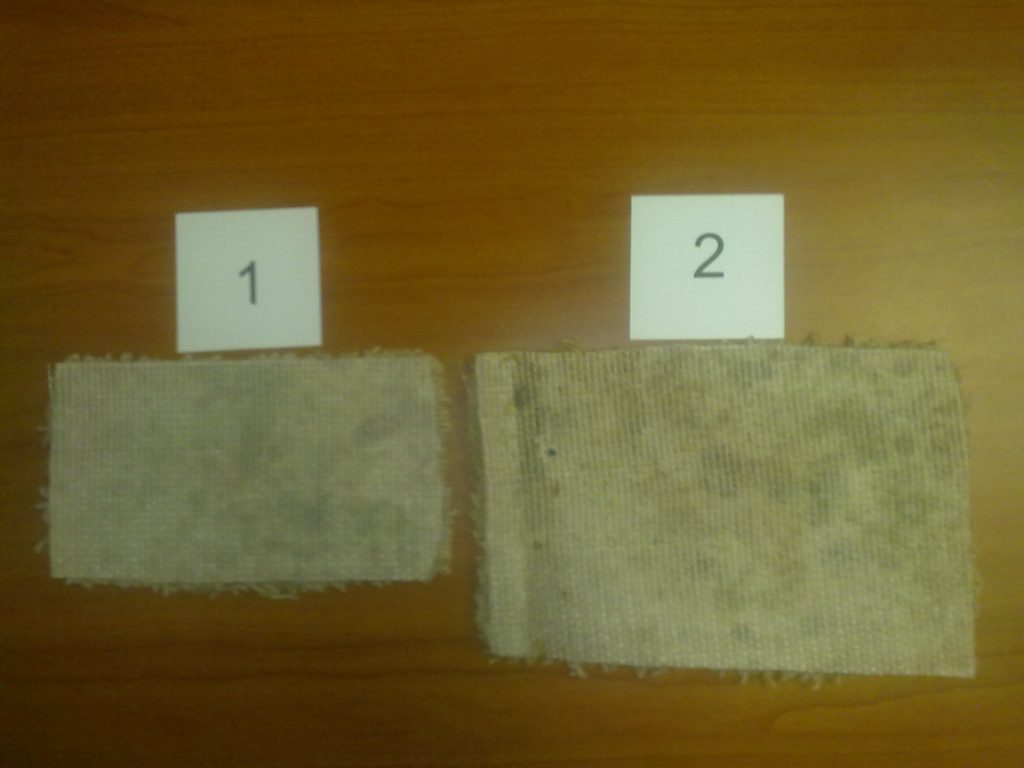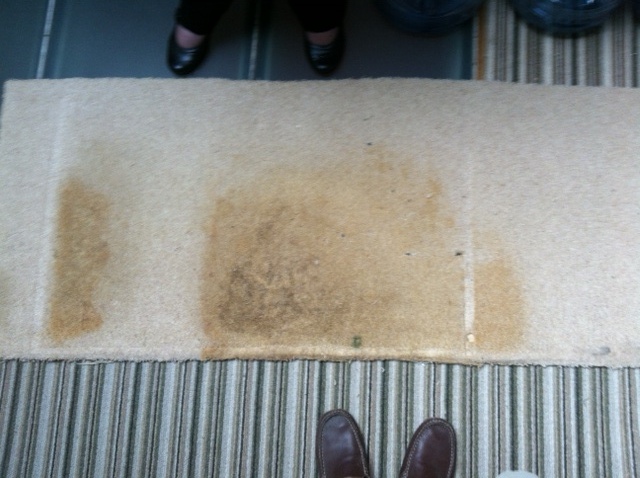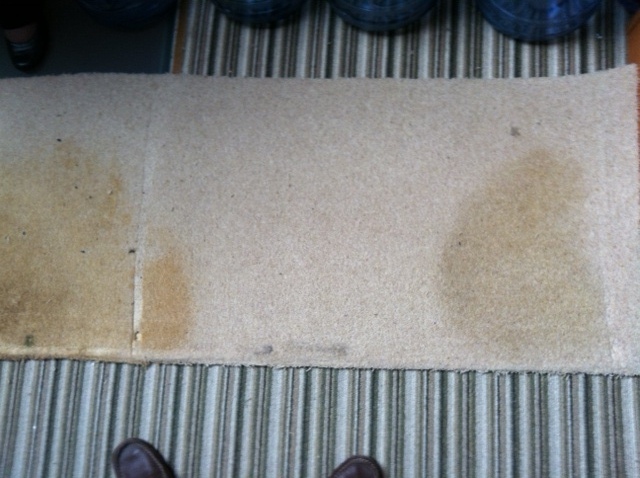Brown Stain on Carpet
Carpet type: Twist Pile, Wool mix, Tufted, Baige colour.
Nature of Issue: When the client vacated the flat he was renting, some large stains were discovered underneath a wardrobe that was positioned in the Hall. The carpet was newly laid after a leak had damaged a wooden floor. The carpet replaced the wood flooring.


Tests:
The following tests were carried out by Mr Kevin Goodwin on the two samples supplied.
We carried out a number of comparative tests on the two pieces of carpet sent by the client:
1. Visual inspection
Two samples were provided to me by the client, sample 1 measuring 160x90mm, sample two measuring 190x127mm.
On first appearance and inspecting the pile, sample one looks like a fairly new piece of carpet. On inspecting the backing of sample one, there are signs of numerous black spots within the backing of the carpet.
On sample two, there are numerous black/brown spots on the pile of the sample. The pile is also very brittle to the touch and there are signs of damage to the pile. On inspecting the backing of sample two, there are black and brown spots and some evidence of minor damage.
It would appear that the liquid has gone from the pile of the carpet and migrated to the backing. The liquid on sample one is minor and probably caused by small splashes of liquid getting onto the pile of the carpet.
2. Damp Test
Negative. Both samples not currently damp.
3. PH Test
Sample one carpet pile PH 6.60
Sample one backing PH 6.40
Sample two carpet pile PH 4.48
Sample two backing 5.70
4. Residue Test
De-ionised water was inserted into and extracted from the pile of both samples.
Clear water extracted from sample one.
A yellow/brown liquid was extracted from sample two.
The residue from both samples two was subject to further pH testing in an attempt to determine the most likely substance.
Sample one PH 6.61
Sample tw0 PH 6.14
Our comments are as follows:
1. It is obvious a liquid substance has got onto the pile of the carpet then into the backing and remained damp over a long period of time.
2. This has caused the black/brown spots on the backing of both samples, the brown colouring, the brittle pile and minor damage of sample two. The stains and damage have been cause by mildew and dry rot as explained in the following paragraph.
3. Mildew is always present in our environment. Mildew spores are carried by air movement and are found virtually everywhere. Mildew doesn’t become a problem until it becomes active and begins to grow. For mildew to become active it must have a damp, dark, warm environment and organic matter. As mildew becomes active and grows, it requires food in the form of organic matter. Mildew is not an odour problem until it becomes active. Mildew becomes active above 20°C and below 30°C. The odour associated with mildew in its active state is caused from the gases that are produced as mildew digests organic matter. Mildew can easily be recognised by its black, greenish, or grey spots or discolouration on the material which it thrives.
The resulting damage from mildew damage is called dry rot. Dry rot results in weakening of fibres or in very severe cases complete disintegration.
4. The pH results of the testing and the damage caused to the samples is consistent to water getting onto the pile of the carpet and left damp for a long period of time.
5. The client claims the wardrobe in the hallway was positioned over the stained and damaged area immediately after the new carpet was laid (see photos Stained Carpet 1, Stained Carpet 2 & Wardrobe).
Conclusion, by Kevin Goodwin:
With the samples and evidence supplied to me, I would conclude that the stained and damaged areas were caused by water getting onto the carpet at some time during the installation of the carpet.
The stained/damaged areas are within the indentations of the edges of the wardrobe, so the wet/damp area would not have been noticed until the wardrobe was moved.
Given that the edges and base of the wardrobe would have ‘sealed’ the water into the carpet, it would have had no opportunity to dry in a normal way. If a large wardrobe like the one in the ‘Wardrobe’ photo was placed onto and sealed a damp/wet carpet, then this type of damage and staining can easily occur.
I can only speculate as to how the water got onto the carpet at this time, for example, it could have been raining the day it was installed and some of the carpet could have got wet.


